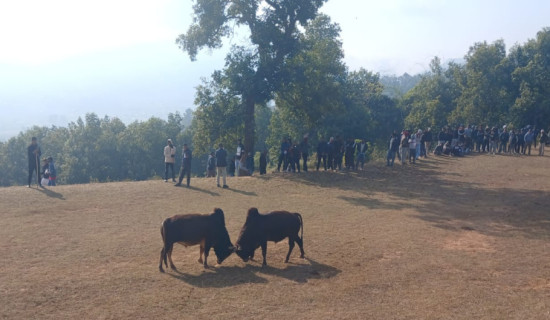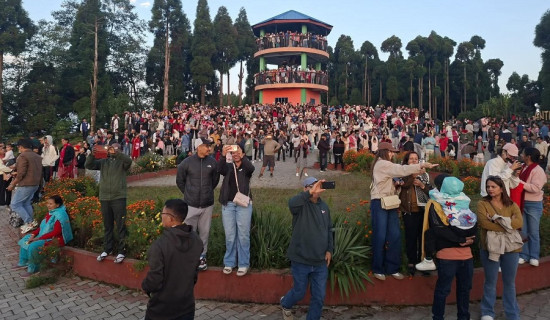- Friday, 2 January 2026
A Worthwhile Collection
Ballav Dahal
Buddhi Narayan Shrestha does not need much introduction as he is Nepal’s seasoned geographer and border specialist. A former Director General at the Department of Survey, Shrestha knows well where the nation feels the pains of frontier encroachment.
While working as a top bureaucrat, he also had the opportunity to lead separate delegations of the Nepal-India Joint Level Boundary Committee and the Nepal-China Boundary Committee. The self-motivated border researcher has as many as 14 books, including one under review, to his credit.
Border Man of Nepal, International Boundaries of Nepal, Border Management of Nepal, India-Nepal Frontier Dams and Knowledge On Boundaries are some of his prominent publications.
All those books seem to be dealing with the country’s boundary-related concerns in one way or the other. With its growing popularity among readers, the publication titled ‘International Boundaries of Nepal’ has already been translated into eight languages—Russian, French, German, Dutch, Italian, Spanish, Portuguese and Polish. In addition, one and a half dozen other books have also been published in co-authorship.
A recipient of numerous prestigious national and international awards and medals, he has made dozens of presentations on boundary demarcation and border management issues. He has also proposed solutions to such sensitive problems.
With a great sense of patriotism, the writer has been lobbying for resolving Nepal’s border problems with neighbours, especially India, once and for all. His point of view is quite convincing and valid because it is based on evidence. Being a painstaking and well-read geographer, Shrestha has been contributing to the nation voluntarily by carrying out in-depth research studies on a myriad of border issues to bring the truth to light.
In his relentless attempt to collect pieces of evidence about the nation’s border problems, he has visited a host of renowned libraries such as the Harvard University Library, MIT Library, Johan F. Kennedy Presidential Library, and British Museum Library, among others. He has also spent money from his pocket on travelling and paying permission fees to some of such libraries.
The book under review is the translated version of the author’s book titled ‘Nepal Sambandhit Sima Naksa Sangraha’. However, the writer has updated some of the texts and added a few others to this book. It is very informative as it contains major historical boundary maps showcasing Nepal's international borders, especially the northwestern part adjacent to India.
This publication incorporates 90 various maps and other necessary shreds of evidence justifying the country's territorial integrity, sovereignty and freedom. It has additional 44 detailed maps along with a zoom version of the vital sections of the maps such as Limpiyadhura, Kalapani and Lipulek.
What is more significant are their meticulous interpretations and explanations. In this publication, the author has made a sequential explanation of what the maps indicate. A detailed analysis of the maps could help resolve the longstanding contested border issues.
Many historical documents and pieces of evidence, including the Sugauli Treaty, show that India has occupied about 372 square kilometres of territory of Nepal in the Lipulek-Limpiyadhura-Kalapani region alone.
The maps and their comprehensive interpretations could be an important resource for the nation to take the much-needed step towards regaining the lost territory. The country did not have such proof in the past. So, the author deserves a lot of appreciation for doing such a nice job for the nation.
The border encroachment issue became more complicated when India published her new political map on November 2, 2019, with the incorporation of Lipulek, Limpiyadhura and Kalapani in it. Naturally, Nepal expressed serious concern over the matter and called for its southern neighbour to hold talks in order to settle the dispute amicably through the diplomatic channel.
But the Indian government did not show its readiness to resolve the issue under one pretext or the other. Instead, on May 8, 2020, India officially opened a link road leading to Kailash Manasarovar in the Tibet Autonomous Region of China through Lipulek.
All the major political parties in Nepal opposed India’s unilateral step. The unsolicited Indian move forced the Nepal government to bring out a revised administrative and political map of the country.
The map incorporates Kalapani, Lipulek and Limpiyadhura in it.
India is not serious about seeking a permanent solution to the border problem with Nepal.
The southern neighbour’s continuous indifference to Nepal’s frequent pleas to initiate dialogue is a clear indication that the former just want to linger on the problem. Its refusal to receive the Eminent Persons’ Group (EPG)’s report on the boundary issues also justifies it.
Ironically, many Indian leaders often say that they want to settle frontier problems through mutual talks and understanding. In such a situation, Nepal must keep following up on the border issues with India.
As the book contains a lot of historical maps and documents, diplomats, as well as researchers focusing on Nepal-India relations, could find it very useful. The book could be worthwhile even for readers who are interested in Nepal-India border issues.
(Dahal is deputy executive editor of this daily.)
How did you feel after reading this news?

















